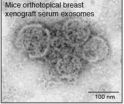(Press-News.org) Scientists used mathematical models to show that analysing genetic data, alongside a range of other risk factors, could substantially improve the ability to flag up women at highest risk of developing breast cancer.
Their study showed that prevention strategies could be improved by testing not only as currently for major cancer predisposition genes such as BRCA1 and BRCA2 - which identify a small percentage of women at very high risk - but also by factoring in data on multiple gene variants that individually have only a small effect on risk, but are more common in the population.
The research was carried out by researchers at The Institute of Cancer Research, London, and the National Cancer Institute in Bethesda, US - and is published today (Thursday) in the Journal of the National Cancer Institute.
The study received funding from The Institute of Cancer Research (ICR), Breakthrough Breast Cancer and the National Cancer Institute.
Researchers stressed that their study was a computer modelling analysis and would need to be confirmed by further research aimed at validating the models they used and assessing real-life prevention approaches.
But they said identifying women at highest risk using genetic and other factors could allow preventative treatments and tailored advice to be offered more effectively, reducing the number of women who develop breast cancer. And genetic testing could be done using currently available technology.
In the study, researchers modelled the potential risk stratification of eight hypothetical scenarios. Depending on the risk factors measured under each scenario, they would use a mixture of a GP or self-administered questionnaire, genetic profiling and mammography scans to measure breast cancer density to calculate risk.
The risk factors were:
genetic profile
family history of breast cancer
age at menarche
number of births and age at first live birth
oral contraceptive use
combined menopausal therapy (MHT) use
body mass index [BMI]
alcohol consumption
smoking status
personal history of benign breast disease [BBD]
breast tissue density.
The most effective of the eight models at predicting breast cancer risk combined analysis of all the risk factors. For instance when applied to 50 year-old women, such a model could identify the most at-risk 10.2 per cent of women - who account for 32.2 per cent of all breast cancer cases.
That means doctors could tell an individual 50-year old woman if she was in the most at-risk 10 per cent of the population - and potentially identify lifestyle changes or preventative treatments to reduce her risk, or provide better advice on the potential benefits and harms of taking hormone replacement therapy to reduce menopausal symptoms.
In the UK, more detailed risk information is only routinely collected for women with a family history of cancer, whose care can be altered if they are thought to have a high chance of carrying a very high-risk genetic mutation, such as one of the BRCA genes.
NICE guidelines recently recommended considering the use of drugs to prevent breast cancer in apparently healthy women found to be at moderate to high risk of developing breast cancer, based on their family history or carrying a very high-risk genetic mutation.
But the great majority of breast cancers occur in women without a known family history of the disease. The new study shows additional genetic testing and risk factor assessment could help more accurately identify women, with and without family history, who are at elevated risk and could benefit most from preventive strategies.
Study leader Professor Monserrat Garcia-Closas, Professor of Epidemiology at The Institute of Cancer Research, London, said:
"Our study shows that genetic testing has the potential to improve strategies for preventing breast cancer, and suggests that multiple, small-effect genetic risk factors could be included alongside the major breast cancer genes to assess risk. We hope it helps to start a wider discussion about how to add more accurate risk prediction tools to future prevention programmes.
"Our models are theoretical and rely on a number of assumptions, and they are only the starting point in this discussion - much more detailed and practical research studies are needed to say exactly how combined risk factor analysis
INFORMATION:
Researchers at the Bellvitge Biomedical Research Institute of Bellvitge, the Catalan Institute of Oncology and the University Hospital of Bellvitge have participated in an international study published in the journal Cancer Cell that describes how exosomes secreted by tumor cells contain protein and microRNA molecules capable of transform neighboring cells into tumoral cells promoting tumor growth.
What are exosomes?
Exosomes are small vesicles which are secreted by all cells and contain proteins and messenger RNAs and microRNAs. At first it was thought that only functioned ...
Researchers at the ARC Centre of Excellence for Coral Reef Studies (Coral CoE) at James Cook University in Australia have found a way to predict illegal fishing activities to help authorities better protect marine reserves.
Marine reserves are the most common strategy used to protect and maintain marine ecosystems around the world.
The International Convention of Biological Diversity aims to have 10 per cent of the world's marine areas protected by 2020.
Many countries are contributing to this target by protecting remote, offshore areas. For example, the United ...
(SACRAMENTO, Calif.) -- This week's issue of the New England Journal of Medicine features an article that highlights an unprecedented analysis of the nation's childhood head injuries. The study, authored by physicians at UC Davis School of Medicine and Washington University School of Medicine, analyzed more than 43,000 children who were evaluated for head trauma at 25 emergency departments around the United States. In the accompanying supplements, detailed information about these children, their presentations and results will be useful to doctors and helpful to policy makers ...
BOSTON, MA - Sleep disorders are independent risk factors for heart attacks and motor vehicle crashes, which are the two leading causes of death for firefighters in the United States. In a national sample of almost 7,000 firefighters, researchers at Brigham and Women's Hospital (BWH) examined the prevalence of common sleep disorders and their association with adverse health and safety outcomes and found that sleep disorders are highly prevalent, and associated with substantially increased risk of motor vehicle crashes and cardio-metabolic diseases among firefighters.
Findings ...
VIDEO:
NC State researchers have developed a new way to transfer thin semiconductor films, which are only one atom thick, onto arbitrary substrates, paving the way for flexible computing or photonic...
Click here for more information.
Researchers from North Carolina State University have developed a new way to transfer thin semiconductor films, which are only one atom thick, onto arbitrary substrates, paving the way for flexible computing or photonic devices. The technique ...
COLUMBUS, Ohio - In six out of 10 cases, ovarian cancer is diagnosed when the disease is advanced and five-year survival is only 27 percent. A new study suggests that a cancer-killing virus combined with a chemotherapy drug might safely and effectively treat advanced or recurrent forms of the disease.
Researchers at The Ohio State University Comprehensive Cancer Center - Arthur G. James Cancer Hospital and Richard J. Solove Research Institute (OSUCCC - James), led the cell and animal study. Reporting in the journal Clinical Cancer Research, the researchers showed that ...
Some people experience cold not only as feeling cold, but actually as a painful sensation. This applies even to fairly mild temperatures - anything below 20°C. A group of researchers from Lund University in Sweden have now identified the mechanism in the body that creates this connection between cold and pain. It turns out that it is the same receptor that reacts to the pungent substances in mustard and garlic.
Professor of Pharmacology Peter Zygmunt and Professor of Clinical Pharmacology Edward Högestätt have long conducted research on pain and the connection ...
For several years the Danish health service has been moving towards increased centralisation and specialisation in large hospital departments based on the thesis that this provides better results for patients. A new study involving more than 12,000 Danish patients with hip fractures presents a different picture, however:
"Our study shows that the mortality rate for this group of patients is lower in the smaller hospital departments compared to the larger departments. We can also see that the length of stay in hospital is shorter and the quality of care is generally better, ...
Stanford, CA--Photosynthesis is the process by which plants convert energy from the sunlight into chemical energy in the form of sugars. These sugars are used by plants to grow and function, as well as food for animals and humans that eat them.
Plants grow in environments where the availability of light fluctuates quickly and drastically, for example from the shade of clouds passing overhead or of leaves on overhanging trees blowing in the wind. Plants thus have to rapidly adjust photosynthesis to maximize energy capture while preventing excess energy from causing damage. ...
Researchers from Denmark and the U.S. report that babies of women with rheumatoid arthritis (RA) or pre-clinical RA--the period prior to symptoms--are 1.5 times more likely to be born prematurely in Denmark. Findings published in Arthritis & Rheumatology, a journal of the American College of Rheumatology (ACR), indicate that body measurements of the baby at birth were only slightly lower in children exposed to maternal or preclinical RA compared to those with no exposure to the disease. Paternal RA was not found to impact fetal growth or preterm birth risk.
Roughly one ...

